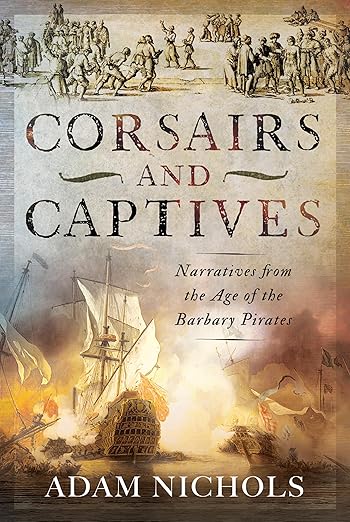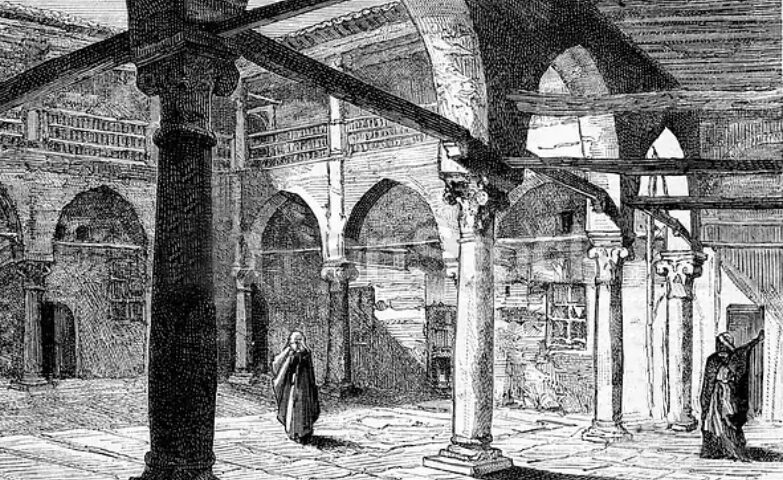Last week, we continued with the story of Helgi Jónsson, the young Icelander who, along with the rest of his family, was captured in the summer of 1627 by corsairs from Salé.
Helgi, remember, wound up in Algiers, where he was sold in the Badestan (the slave market) to a Bölükbaşı, a janissary captain.
We ended last week’s post with the following:
The Icelandic sources provide no details about what Helgi’s life aboard a corsair ship might have been like, but there is another captivity narrative, penned by another European captive who also served as a slave to a seagoing janissary officer. Helgi’s experiences were no doubt similar to this man’s.
The man was René du Chastelet des Boys.
Des Boys’ family was among the noblesse de robe (nobles of the robe), lesser French aristocrats whose rank derived from their service in administrative and judicial posts (those employed in such positions wore traditional robes of office, hence the name). They were magistrates, and since his parents intended that he should follow in that venerable calling, when he came of age, they packed René off to the Université d’Orléans to study law.
I have previously posted des Boys’ narrative here in this blog (a fifteen-part series titled The Odyssey of René du Chastelet des Boys, posted back in 2020), but it seems worth re-posting part of it here because des Boys’ narrative contains a detailed description of what it was like to serve as a slave to a janissary officer onboard a corsair galley—and his experience no doubt mirrors that of Helgi Jónsson’s.
Since those previous posts containing des Boy’s narrative also contain a biographical introduction there seems no need to go into such biographical details here. Suffice it to say that des Boys’ time at the university as a student of law was a resounding failure, and that, eventually, he fled his home with some acquaintances and took ship to Portugal to offer his services to the Portuguese king.
On the way, sometime in the summer of 1641, when he was around twenty-two years old, his ship was attacked and captured by corsairs from Algiers, and des Boys ended up enslaved in that city. Years after his eventual safe return to France, des Boys penned an account of his experience as a slave in Algiers. This account was part of a larger work titled L’Odyssée ou diversité d’aventures, rencontres et voyages en Europe, Asie et Afrique, divisée en quatre parties (The Odyssey, or a Diversity of Adventures, Meetings and Travels in Europe, Asia, and Africa, Divided into Four Parts).
Here is the the beginning of that part of des Boys’ narrative containing the details of his time enslaved to the janissary officer.
Des Boys’ narrative was originally written in French. As far as I know, L’Odyssée has never been systematically translated into English before, so the text below is the first ever English rendering of des Boys’ story.
Keep in mind as you read that des Boys’ story is his own, but that it also depicts the sorts of experiences endured by Helgi Jónsson and other enslaved captives like him (there were many) who found themselves forced to serve aboard Barbary corsair ships.
We start the story as des Boys is sold by his previous owner and bought by the janissary officer.
I remained in the house of Fatima, my patroness, for another four to five days. Then, upon the advice of her brother, who counselled her to sell me, for he considered me to be a useless slave (and far too familiar with her), I was led to the slave market for the third time. And so I ended up in the hands of my third owner, an Ouda Bachi—a company commander in the janissaries. I passed out of service of the house of Fatima for sixty pieces of eight. She received the money from my auction through the hands of her brother. I took my leave of her with some regret.
The Ouda Bachi who purchased me was called Beiram (family names being unknown among the Turks). He had a nickname: Topeclaure, meaning ‘big leg.’ I thus became known as the slave of the Ouda Bachi Topeclaure.
My new owner brought me to the janissary barracks in which he lived. There, he put me in charge of the cooking, which was done in the evening in common among the soldiers. The janissaries were divided up into brigades and housed close to each other in dormitories, like the cells of our religious houses. In the middle of the building in which they lived was a large courtyard, resembling the cloister of an abbey.
I was soon able to set myself up successfully as a cook in the Beiram brigade, having learned in a few days how to season white cabbage with chili and orange, how to prepare rice and couscous with chicken, and how to lay out honey and oil with hot bread. Cooking fish was just as easy, for frying and poaching were the only methods employed—the Turks being neither so greedy for, nor so fond of food as we are in Europe.
Beiram was satisfied enough with my service that soon he commanded me to organize supplies needed for him to join a corsair expedition aboard one of the more important corsair vessels, named The Small Moor. Onto this vessel, I carried, in a single case, his basic necessities, which included a bunch of onions, a stick of tobacco, and a small barrel of brandy. As well as these, I brought along the staples that all Turkish soldiers going to sea carry with them: oil, olives, vinegar, and hardtack biscuits—since onboard provisions do not consist of very much and are distributed among them only twice a day.
There were fifteen other slaves on board this corsair ship, mostly Flemish and English, with me being the lone Frenchman. There were also fifty Turks on board, plus ten or twelve Kouloughlis, who were the sons of those among the Turkish janissaries who had married local women. Kouloughlis were not included among the ranks of Algiers’ state militia [the janissaries]. The garrison payroll is intended solely for the Turks whom the Pashas bring in from the Levant, or for the renegados among their ranks. Any children got with native women are usually excluded.
A dozen years ago, these Kouloughlis launched a rebellion and, in an attempt to take control of the city and the state, captured the Alcassave [al-Qasaba, the fortress at the top of the city of Algiers]. They were besieged by both Turks and renegados, many of them fathers of the rebels. The Kouloughlis’ resistance was so stubborn that they blew up the Alcassave. Those who survived lost their heads. In my own time, some of these severed heads still decorated the walls around the Bab al-Oued gate [one of the city gates of Algiers]—a pitiful relic of paternal revenge, for most of the besieged and the besiegers were fathers and sons, uncles and nephews, or at least first cousins. Since that time, the Kouloughlis have had no voice in the government of Algiers, do not receive any public pay, and are permitted to join corsair expeditions only on the condition that they receive no wages or salaries but just a simple share in the common profits.
Notwithstanding all this, the captain of The Small Moor was, in fact, a Kouloughli, a man named Joseph Reis, who was the son of a young janissary from the Levant who had married a Morisco woman. Although my master, the Ouda Bachi, did not consider Joseph Reis to be a man of any importance ashore, he nevertheless yielded to his authority aboard ship because the ship owner so wished. This man, who had armed and equipped the ship himself, had given command of it to Joseph Reis because of his leadership skills, loyalty, and experience.
For the next instalment of René du Chastelet des Boys’ narrative, see the next post here in this blog.

Corsairs and Captives
Narratives from the Age of the Barbary Pirates
View Amazon listing
The Travels of Reverend Ólafur Egilsson
The story of the Barbary corsair raid on Iceland in 1627
View Amazon listing